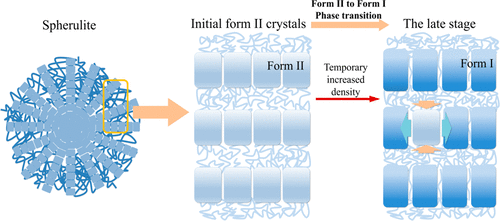当前位置:
X-MOL 学术
›
Macromolecules
›
论文详情
Our official English website, www.x-mol.net, welcomes your feedback! (Note: you will need to create a separate account there.)
Retardance of Form II to Form I Transition in Polybutene-1 at Late Stage: A Proposal of a New Mechanism
Macromolecules ( IF 5.5 ) Pub Date : 2018-03-07 00:00:00 , DOI: 10.1021/acs.macromol.7b02481 Yongna Qiao 1, 2 , Hai Wang 1 , Yongfeng Men 1, 2
Macromolecules ( IF 5.5 ) Pub Date : 2018-03-07 00:00:00 , DOI: 10.1021/acs.macromol.7b02481 Yongna Qiao 1, 2 , Hai Wang 1 , Yongfeng Men 1, 2
Affiliation

|
The retardation of polybutene-1 form II to form I transition in the late stage has been investigated by means of time-resolved wide-angle X-ray diffraction. Form II samples with different lamellar thickness and constituent in amorphous phase were generated via varying crystallization temperature and molecular weight and aged at room temperature for the form II to form I transition. The II to I polymorphic transition in polybutene-1 undergoes two stages, where slow nucleation and rapid growth proceed in the first stage and extremely slow secondary nucleation and growth take place in the late stage. The degree of transition reaches a plateau value in the late stage of transition, which depends highly on crystallization temperature and molecular weight that low molecular weight and high crystallization temperature always contribute to a greater degree of transition, but is less affected by the kinetics in the first stage. According to the crystal unit cell parameters of form II and form I, there should be an extension in the normal direction of lamellae and a shrinkage in the lateral direction during phase transition, which thus would induce an additional pressure in the normal direction and the tendency to expansion in the lateral direction on the residual from II crystallites. As a result, the nucleation and further growth of the II to I transition are retarded. Low molecular weight and high crystallization temperature lead to larger content of chain ends and higher chain mobility in the amorphous phase; hence, the samples are more likely to release the unfavorable factors restraining generation of form I nuclei to some extent. The transition degree in late stage is thus an intrinsic property of PB-1 samples determined by their microstructures and would not be influenced by the transition behavior in the first stage.
中文翻译:

聚丁烯-1中晚期从II型到I型过渡的迟缓:一种新机制的建议
已经通过时间分辨的广角X射线衍射研究了聚丁烯-1从形式II到形式I的转变在后期的阻滞作用。通过改变结晶温度和分子量,生成具有不同层状厚度和非晶相组成的II型样品,并在室温下将II型形成I型过渡。聚丁烯-1中的II到I多晶型转变经历两个阶段,其中在第一阶段进行缓慢的成核和快速生长,而在后期进行极慢的二次成核和生长。过渡程度在过渡后期达到稳定值,在很大程度上取决于结晶温度和分子量的是,低分子量和高结晶温度总是有助于较大的转变程度,但在第一阶段受动力学的影响较小。根据晶型II和晶型I的晶胞参数,相变过程中应在片晶的法线方向上延伸,并在横向方向上发生收缩,这将在法线方向上引起额外的压力并趋向于II微晶的残余物沿横向扩展。结果,II至I过渡的成核作用和进一步的生长受到阻碍。低分子量和高结晶温度导致无定形相中链末端的含量增加和链迁移率提高;因此,样品在一定程度上更可能释放出不利的因素以抑制I型核的生成。因此,后期的转变程度是PB-1样品的固有性质,这是由其微观结构决定的,不会受到第一阶段的转变行为的影响。
更新日期:2018-03-07
中文翻译:

聚丁烯-1中晚期从II型到I型过渡的迟缓:一种新机制的建议
已经通过时间分辨的广角X射线衍射研究了聚丁烯-1从形式II到形式I的转变在后期的阻滞作用。通过改变结晶温度和分子量,生成具有不同层状厚度和非晶相组成的II型样品,并在室温下将II型形成I型过渡。聚丁烯-1中的II到I多晶型转变经历两个阶段,其中在第一阶段进行缓慢的成核和快速生长,而在后期进行极慢的二次成核和生长。过渡程度在过渡后期达到稳定值,在很大程度上取决于结晶温度和分子量的是,低分子量和高结晶温度总是有助于较大的转变程度,但在第一阶段受动力学的影响较小。根据晶型II和晶型I的晶胞参数,相变过程中应在片晶的法线方向上延伸,并在横向方向上发生收缩,这将在法线方向上引起额外的压力并趋向于II微晶的残余物沿横向扩展。结果,II至I过渡的成核作用和进一步的生长受到阻碍。低分子量和高结晶温度导致无定形相中链末端的含量增加和链迁移率提高;因此,样品在一定程度上更可能释放出不利的因素以抑制I型核的生成。因此,后期的转变程度是PB-1样品的固有性质,这是由其微观结构决定的,不会受到第一阶段的转变行为的影响。



























 京公网安备 11010802027423号
京公网安备 11010802027423号